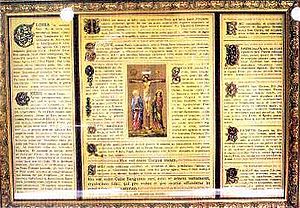
Altar cards
Encyclopedia

Altar
An altar is any structure upon which offerings such as sacrifices are made for religious purposes. Altars are usually found at shrines, and they can be located in temples, churches and other places of worship...
during the Tridentine Mass
Tridentine Mass
The Tridentine Mass is the form of the Roman Rite Mass contained in the typical editions of the Roman Missal that were published from 1570 to 1962. It was the most widely celebrated Mass liturgy in the world until the introduction of the Mass of Paul VI in December 1969...
. They contain certain prayers that the priest must say during the Mass, and their only purpose is as a memory aid, although they are usually very beautifully decorated.
History
Altar cards were not used before the sixteenth century, and even today they are not used when a Bishop celebrates the traditional Mass, because he reads the entire Mass from the Pontifical Canon. When Pope St. Pius VPope Pius V
Pope Saint Pius V , born Antonio Ghislieri , was Pope from 1566 to 1572 and is a saint of the Catholic Church. He is chiefly notable for his role in the Council of Trent, the Counter-Reformation, and the standardization of the Roman liturgy within the Latin Church...
restored the Missal, only the card at the middle of the altar was used, and it was called the "Tabella Secretarum". The left card was added first, and then the right one was added for the sake of symmetry.
Content of the cards
The altar card on the left contains the Last Gospel (John 1:1-14), which is said at the very end of the Mass. The card on the right contains the prayer for blessing the wine and water ("Deus qui humanae substantiae") and the psalm Lavabo, which the priest says when he washes his hands.The center card contains the Gloria
Gloria in Excelsis Deo
"Gloria in excelsis Deo" is the title and beginning of a hymn known also as the Greater Doxology and the Angelic Hymn. The name is often abbreviated to Gloria in Excelsis or simply Gloria.It is an example of the psalmi idiotici "Gloria in excelsis Deo" (Latin for "Glory to God in the highest")...
, the prayer Munda cor meum which the priest recites before reading the Gospel, the Credo
Nicene Creed
The Nicene Creed is the creed or profession of faith that is most widely used in Christian liturgy. It is called Nicene because, in its original form, it was adopted in the city of Nicaea by the first ecumenical council, which met there in the year 325.The Nicene Creed has been normative to the...
, the prayer for offering the Host (Suscipe, Sancte Pater), the words of Consecration and several of the prayers of the Canon of the Mass
Canon of the Mass
Canon of the Mass is the name given in the Roman Missal, from the first typical edition of Pope Pius V in 1570 to that of Pope John XXIII in 1962, to the part of the Mass of the Roman Rite that begins after the Sanctus with the words Te igitur...
. Usually in the centre there is a picture of the Crucifixion
Crucifixion
Crucifixion is an ancient method of painful execution in which the condemned person is tied or nailed to a large wooden cross and left to hang until dead...
.
Uses and regulations of altar cards
The altar cards may only stand on the altar during Mass. The center one stands against the TabernacleChurch tabernacle
A tabernacle is the fixed, locked box in which, in some Christian churches, the Eucharist is "reserved" . A less obvious container, set into the wall, is called an aumbry....
, altar cross or other support, and the left and right ones stand against either the candlesticks or the superstructural steps of the altar. After Mass, they must either be removed or placed face downwards under the altar cover. The cards must be removed for Exposition of the Blessed Sacrament.

